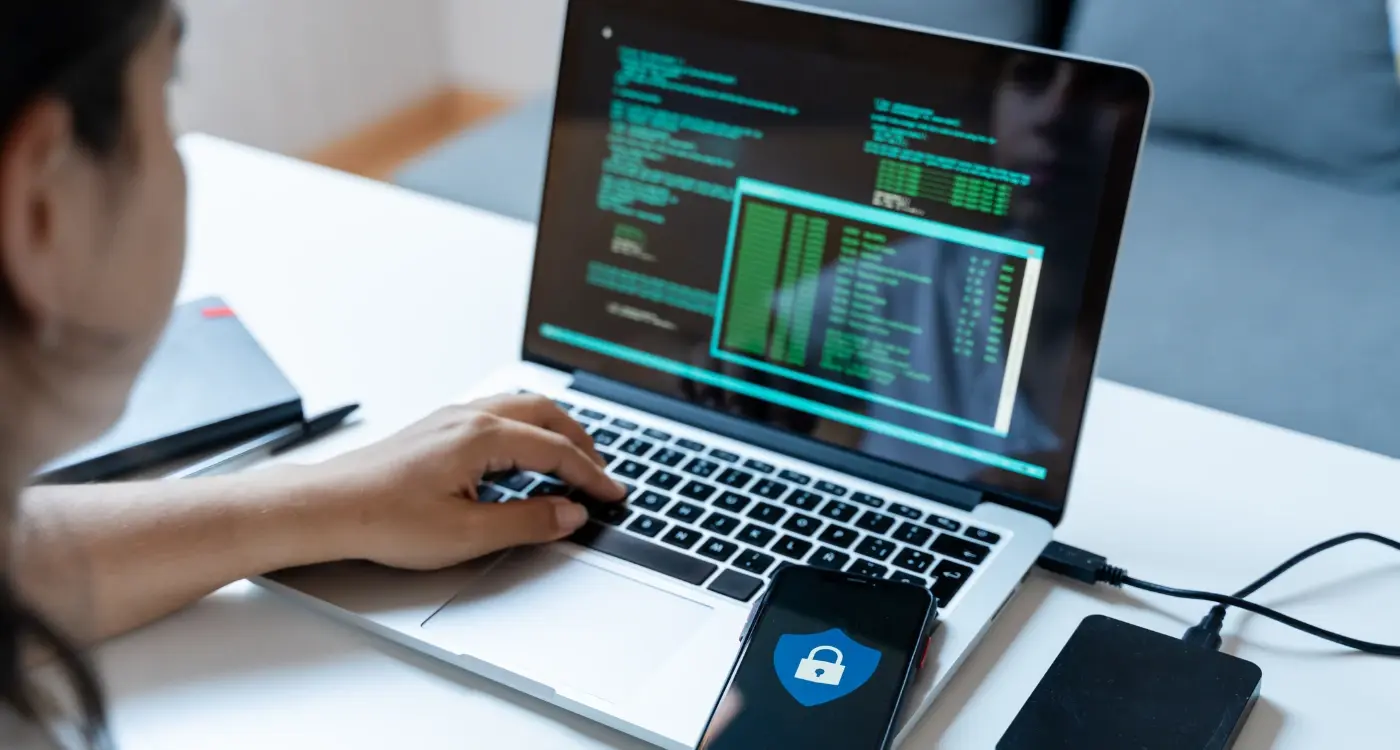How Do I Make Sure My App Is Secure?
We've all been there: excited about launching the next big app, hoping to capture the market's attention and conquer your niche. But, amidst all the buzz, there's that worry: Is my app secure? It's understandable. With cyber threats lurking around every digital corner, ensuring your app's safety is no less critical than its features or user experience.
At Glance, we get it. Safety equals trust, and without trust, even the most innovative app can fall flat. Think of your app as a bank vault and the data it holds as the money. You wouldn't build a bank vault without sturdy walls and a good door, would you? Your app's security acts as these defences, protecting your users' data and your business reputation from potential theft. We're here to guide you through every step to fortify that digital vault.
An unprotected app is a bit like a cookie without a jar – easy for anyone to snatch.
So, what can you expect from this guide? By the end of it, you'll not only understand the common threats and pitfalls but also be equipped with best practices and actionable steps to ensure your app remains as secure as a bank vault. Ready to dive in? Let's get started!
Understanding the Importance of App Security
When your app is getting rave reviews, and users are loving it, somewhere, in the dark corners of the internet, someone sees your app as an opportunity. They see vulnerabilities where you see features, and if they exploit those, it could spell disaster for your business.
App security isn't something to be neglected. Ensuring your app is secure means protecting sensitive user data, maintaining your brand's reputation, and avoiding costly legal ramifications. As a business, your responsibility goes beyond just delivering a functional app. Your users trust you with their personal information, and breaching that trust can lead to serious consequences.
In our increasingly interconnected world, these threats are ever-evolving. App security is not a one-time item to check off your list. It's an ongoing commitment to your users that you will be vigilant and take proactive measures to keep their data safe.
Common App Security Risks for Businesses
One of the most commonly heard of risk is that of a data breach, you see these online all the time. This is where hackers gain access to your customers' personal information, names, addresses, and even credit card details (if you're silly enough to store them!). It's every business owner's nightmare but one that can often be avoided.
Another common threat you most likely have heard of is that of malware and viruses. These are nasty bits of code that can steal info, damage your system, or even hold your data hostage. Yup, ransomware is a thing and it even hits big companies. Not fun.
Next, we have what is called an injection attack. This is where hackers sneak malicious code into your app through input fields (like login forms). It's like letting a fox into the henhouse but sneakier and definitely more damaging.
There are also insecure APIs. An API is the bridge between your app and other services. If these bridges have gaps or weak points, hackers can exploit them to access your data (and your customers).
| Type of API Vulnerability | Potential Risk | Example |
|---|---|---|
| Broken Authentication | Unauthorized access to sensitive data | Using default passwords |
| Data Exposure | Leakage of private data | Transmitting data without encryption |
| Rate Limiting Issues | Service disruption due to bot attacks | Unlimited API requests |
| Injection Attacks | Execution of malicious code | SQL injection in search fields |
| Security Misconfiguration | Vulnerabilities left unchecked | Debugging enabled in production |
Oh, and human error. Yup, it's not just about the technology. An employee using "password123" as their password or falling for a phishing email can jeopardise your entire security setup. Knowing these risks is the first step in protecting your app. As the saying goes, "Forewarned is forearmed." Let's make sure we're all fully armed for battle!
Why Your App Isn’t as Secure as You Think
It’s easy to assume your app is safe just because it hasn’t been attacked yet. But let’s face it, most businesses don’t invest enough time and resources into app security until it’s too late. And why is that? Well, here are a few reasons:
- Resource Constraints: Developing and securing an app can be difficult. There’s a lot to do and often not enough time, money, or talent to do it all. This can lead to cutting corners on security measures.
- Tight Deadlines: Speed is of the essence in today’s competitive business environment. Tight deadlines mean that security checks sometimes get pushed to “next time.” Unfortunately, “next time” doesn’t always come before an attack does.
- Lack of Security Knowledge: Not every developer is also a security expert. Sure, they can create amazing functionality, but when it comes to tightening security, they might not be up to the task.
Even with the best intentions, these factors can leave your app’s defences open. For example, omitting updates to third-party libraries or underestimating the importance of secure coding practices can turn minor oversights into major vulnerabilities.
Understanding these common pitfalls is the first step towards fortifying your app. So, while you may feel confident right now, remember—security isn’t a one-time task. It’s an ongoing commitment.
Best Practices for Building a Secure App
When it comes to building a secure app, we need to think of it like constructing a fortress. You wouldn’t build a castle without strong foundations, right? The same goes for your app. Let's break down some best practices that will help you fortify your creation from the ground up.
1. Use Secure Code: Start with the basics. Writing secure code is the cornerstone of application security. Ensure your developers follow coding standards and guidelines that emphasise security, such as OWASP's top ten security risks. Regularly review and update your code to patch vulnerabilities as they are discovered.
2. Employ Encryption: Encryption is like sending a secret message in a code only the receiver can unlock. Use strong encryption techniques for both data at rest (stored data) and data in transit (data being sent and received). This ensures sensitive information remains confidential and tamper-proof.
3. Implement Authentication and Authorisation: Don’t let just anyone waltz into your app. Implement robust user authentication and authorisation methods. Use multifactor authentication (MFA) and ensure that user roles and permissions are well-defined and enforced.
4. Regular Security Testing: Schedule regular security tests, such as penetration testing and code reviews. Identifying weaknesses before cyber attackers do can save you from potential breaches.
5. Keep Dependencies Up to Date: Your app likely relies on various third-party libraries and frameworks. Regularly update these dependencies to mitigate vulnerabilities. Using outdated components is like having a rusty lock; it won't stand up to modern threats.
6. Educate Your Team: Ensure everyone in your team is aware of security best practices. Conduct regular training sessions and keep them informed about the latest security trends and techniques. A well-informed team is your first line of defence.
7. Employ a Secure Software Development Lifecycle (SDLC): Integrate security at every stage of your software development lifecycle, from planning and designing to deploying and maintaining. This approach ensures that security isn't an afterthought but a fundamental part of your app’s DNA.
Remember, building a secure app is an ongoing process. Just like maintaining a castle, it’s important to stay vigilant and proactive. By following these best practices, you’ll not only build a secure app but also gain the confidence and trust of your users.
Feeling a bit more secure already? We hope so!
What to Do When Your App Security Is Breached
Discovering that your app's security has been breached can be a gut-wrenching experience. But don't worry, we’re here to help you work through it.
First things first, don’t panic. It’s easy to freak out, but staying calm and collected is the key. Speed is crucial, but making hasty decisions without thinking them through can lead to more problems than solutions.
- Assess the Situation: Before you start plugging holes, you need to understand the extent of the breach. What kind of data has been compromised? Is it user information, internal data, or financial records? Identifying the type and scope of the breach will guide your next steps.
- Contain the Breach: Once you know what's been hit, the next move is to stop the bleeding. This could mean shutting down part of your system, revoking user access, or disconnecting from networks. The goal is to prevent the attacker from accessing any more information.
- Communicate: Transparency is your best friend right now. Inform your internal teams, and if necessary, your customers. Nobody likes bad news, but finding out from you is a lot better than discovering it through leaked data. Be clear about what happened, what you're doing to fix it, and how you’ll prevent it in the future.
- Investigate: Engage your security team or hire a third-party expert to investigate the breach thoroughly. Understanding how the attackers got in will help you seal up vulnerabilities and prevent future attacks. They’ll trace the breach back to its source and provide a detailed report on what went wrong.
- Fix and Update: With the investigation results in hand, you can now patch vulnerabilities, update security protocols, and ensure all systems are up to date with the latest security measures. Remember to update your app and any other affected systems regularly.
- Review and Learn: Every breach is a lesson. Conduct a full review of your policies and procedures, and make the necessary changes to improve your app’s security. Consider it an opportunity to turn a negative experience into a stronger, more resilient security posture.
- Test Again and Again: Before you declare the storm over, conduct thorough security tests to ensure your app’s defence mechanisms are robust. Regular security audits and penetration testing are vital in keeping your app secure in the long haul.
- Legal Obligations: Depending on the nature of the data breach, you might have legal responsibilities to report it to certain authorities or stakeholders. Always stay informed about the compliance and legal considerations for your specific industry.
Remember: Breaches happen, even to the best of us. What matters most is how you respond and what you learn from it. We're always here to provide expert guidance if you need it. Stay vigilant, stay informed, and keep your digital doors locked tight.
Compliance and Legal Considerations for App Security
When it comes to compliance and legal considerations, the stakes are extraordinarily high. There are numerous regulatory guidelines you must adhere to, depending on where your business operates and the nature of the data processed. For instance, the GDPR (General Data Protection Regulation) in Europe or the CCPA (California Consumer Privacy Act) in the United States set stringent requirements for data privacy and security. Non-compliance with these regulations can lead to hefty fines and legal consequences, so, it's in your best interest to stay within the rules.
To help ensure compliance, it's crucial to engage your security and compliance teams right from the outset. Their expertise can offer valuable insights and help you navigate the maze of legal requirements. A proactive approach here can save you from a world of pain later.
Security is not a product, but a process.Bruce Schneier
Additionally, consider following security blueprints provided by reliable sources like Azure. These blueprints offer a guided path to building compliant cloud applications, ensuring you’re not missing out on any critical security protocols.
And let's not forget about third-party vendors. When you’re integrating third-party services or elements into your app, always evaluate their compliance with the necessary security requirements. Just like you wouldn’t entrust your house keys to a stranger, don't let unvetted third parties have access to your app’s data and systems.
At the end of the day, developing secure software is a challenging but critical task. It’s not just a checkbox on your project plan; it’s a mindset that needs to permeate every stage of your development process. By embedding security into your app’s DNA right from the start, you'll not only avoid legal pitfalls but also build trust with your users. And trust, as we know, is the foundation of any successful business relationship.
The Future of App Security
As the digital landscape evolves, so do the methods used by cyber attackers. Staying up to date with emerging trends in app security isn't just a good idea—it's essential for keeping your business and your customers safe. Here are some key trends to watch in the coming years.
Artificial Intelligence and Machine Learning
No, we're not talking about robots taking over the world. AI and machine learning (ML) are becoming powerful tools in the quest to enhance app security. These technologies can help detect unusual patterns of behaviour, predict potential security threats, and even automate threat response. Think of it as having an always-on mini detective working day and night to keep your app secure.
Zero Trust Architecture
Gone are the days when you could trust everyone within your network. The Zero Trust model operates on the principle that no one should be trusted by default, whether they're inside or outside your network. This security approach requires strict identity verification for every person and device trying to access your resources, adding an extra layer of protection.
Quantum Computing
Sounds like something out of a sci-fi movie, doesn't it? While quantum computing isn't quite mainstream yet, it's poised to revolutionise the field of cybersecurity. Quantum computers will be able to solve complex encryption algorithms much faster than conventional computers, meaning current encryption methods could become obsolete. Staying ahead of quantum computing advancements will be crucial.
Blockchain Technology
Originally known for its role in cryptocurrency, blockchain technology is making waves in the security world too. Its decentralised nature makes it incredibly difficult for hackers to alter existing data records. This makes blockchain a promising solution for securing sensitive information and verifying identities without the need for centralised control.
Biometric Authentication
Remember all those spy movies where the hero scans their retina or fingerprint to access a locked room? That technology has been a reality for enhancing app security for some time. Biometric authentication uses unique biological traits, like your fingerprint or facial recognition, to verify your identity. It’s not only more convenient but also much tougher for attackers to forge compared to traditional passwords.
Conclusion
Securing your app is a journey, not a destination. We understand that for business owners, this can seem like a daunting, never-ending task. But here's the good news: you don't have to go it alone. At Glance, we believe in the power of partnership, supporting you through each step, demystifying tech jargon, and translating it into actionable strategies that protect your business.
By closely following the best practices we've outlined, from regular security audits to staying updated on the latest security trends, you can build a robust defence against potential threats. And if things go wrong, as they sometimes do, don't panic. With a solid incident response plan and a commitment to learning from each breach, you’ll be more resilient and better prepared for the future.
Remember: technology might change rapidly, but a secure app is built on timeless principles of vigilance, regular updates, and thorough testing. Your app’s security doesn’t only safeguard data; it builds trust with your users, strengthens your brand’s reputation, and ultimately contributes to your business’s success. And trust us, there's no greater peace of mind than knowing your app is safe and sound.
If you feel a bit overwhelmed, don't worry, we're here to make the complex more understandable. Reach out to us at Glance if you need any advice on app security, and let’s start the journey to a safer, secure app.
Share this
Subscribe To Our Learning Centre
You May Also Like
These Related Guides

How Do Code Reviews Prevent Security Issues in Mobile Apps?

How Do I Secure My App's API From Unauthorised Access?



